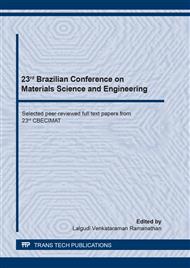[1]
J.C.A. Galvão: Study of the properties of concretes of CP V ARI cement and CP II - F 32, under different mixing temperatures and curing methods. Doctoral (Thesis). Curitiba, 2003. Universidade Tecnológica Federal Paraná (UTFPR). (PR). (In Portuguese).
DOI: 10.21474/ijar01/1535
Google Scholar
[2]
A.M. Neville: Properties of Concrete. (Pini 2nd Edition São Paulo, 1997). (In Portuguese).
Google Scholar
[3]
V.S. Ramachandran, R. Feldman, J.J. Beaudoin: Concrete Science. (Heyden London, 1981).
Google Scholar
[4]
M.V.S. Muniz: The influence of the accelerator and retardant additives on the Portland cement paste. Monograph. State University of Feira de Santana, Feira de Santana, 2008. (In Portuguese).
DOI: 10.47593/2675-312x/20223502eabc289
Google Scholar
[5]
A. Neves Junior, S.R. Ferreira, R.D. Toledo Filho, E.M.R. Fairbairn, Jr. Dweck: Composites Engineering Part B Vol. 163 (15) (2019), p.351.
Google Scholar
[6]
L.E. Burris, K.E. Kurtis: Cement and Concrete Research Vol.104 (2018), p.105.
Google Scholar
[7]
V.M. Lopes. Treatment of solutions containing citric acid and immobilization in Portland cement. Master (Dissertation). São Paulo, 1998. Institute of Energy and Nuclear Research (IPEN). (SP) (In Portuguese).
Google Scholar
[8]
L.A.F. Bauer: Building Materials. (Ed. S.A. vol. 1. 2nd ed. Rio de Janeiro, 1985). (In Portuguese).
Google Scholar
[9]
G.A. Teixeira et al.: Study of the productivity of citric acid in the process of crystallization in vibrated bed: crystallizers in series. FAZU Vol. 7 (2010), p.130. (In Portuguese).
Google Scholar
[10]
R.S.A Carmo. Citric acid: a study of commercial and technical feasibility of their use in the textile processing industry. Master (Dissertation). São Paulo, 2015. University of São Paulo. (SP). (In Portuguese).
Google Scholar
[11]
M. Heikal et al.: Ceramics – Silikáty, S.l. 1 59 (2015), p.17.
Google Scholar
[12]
G. Möschner et al.: Cement and Concrete Research Vol. 39 (4) (2009), p.275.
Google Scholar
[13]
G. Velazco, J.M. Almanza, D.A. Cortés, J.C. Escobedo, J.I. Escalante-Garciaet: Materiales de Construcción Vol. 64 (316) (2014), p.36.
Google Scholar
[14]
J.R. Garcia, I.R. Oliveira, V.C. Pandolfelli: Cerâmica Vol. 53 (325) (2007), p.42.
Google Scholar
[15]
T. Sugama: Citric Acid as a Set Retarderfor Calcium Aluminate Phosphate Cements. Washington: Brookhaven National Laboratory, (2005).
DOI: 10.2172/15011163
Google Scholar
[16]
G. Kastiukas et al.:Construction and Building Materials Vol. 101 (1) (2015), p.389.
Google Scholar
[17]
J.W. Lukaszewicz, I. Michniewicz: The possibility of using roman cement as a binder of repair mortars to restore porous stones. 12th International Congress on Deterioration and Conservation of Stone. New York, 21-25 October 2012. Proceeding... New York 2012. (USA).
Google Scholar
[18]
E.G.R. Petrucci: Portland Cement Concrete. (Ed. Globo, 14. ed. São Paulo 2005) (In Portuguese).
Google Scholar


